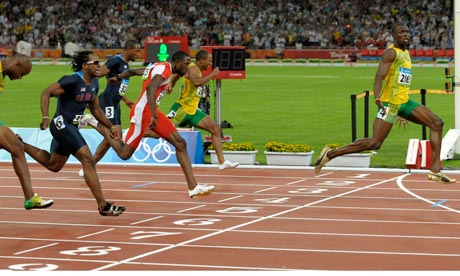How does Usain Bolt run so fast?
Bolt is basically an abberation - when you're that big, you shouldn't be able to run that fast because muscle speed is generally related to size (e.g. squirrels move faster than giraffes). Sprinters are usually short and have more fast-twitch muscle fibers so they accelerate quicker but can't run longer distances. 800m runners are usually taller but with less fast-twitch muscle fibers. Bolt, however, is tall
and has the fast-twitch fibers.
Physiologist Peter Weyand divides each cycle of a runner’s leg into what happens 1) when their foot is in the air, and 2) when it’s on the ground.
- (1) is shockingly irrelevant - at top speed, every runner (even grandpa) takes ~.3 seconds to pick their foot up and put it down again.
- (2) For most, the amount of force applied when on the ground determines speed. Calf muscles, and then hip muscles, are the prime determiners for creating this force. For this, runners can either exert the same force over a longer period (e.g. like a cheetah) or hit the ground harder. Great sprinters hit the ground with a force ~2.5 times their body weight (vs. ~2 for average people). Usain Bolt, weighing 210 lbs, creates 990 lbs of force - 4.7 times his weight.
What is the limit of human speed?
- Non-physiological factors: being quicker off the block, running with a stronger tailwind, running at higher altitudes where thinner air exerts less drag
- Mathematician Reza Noubary calculated, “the ultimate time for [the] 100 meter dash is 9.44 seconds.”
- Weyand, however, say its not predictable - especially with gene therapy avenues out there.









